#the boulevard du temple
Explore tagged Tumblr posts
Text

Rethinking Fashion Photography
The dawn of fashion photography took place after Louis Daguerre (1787-1851) made the first daguerreotype featuring people, View of the Boulevard du Temple, in 1838. This breakthrough sparked a proliferation of such images, with snapshots of actresses, dancers and debutants, spreading awareness of the new technology.
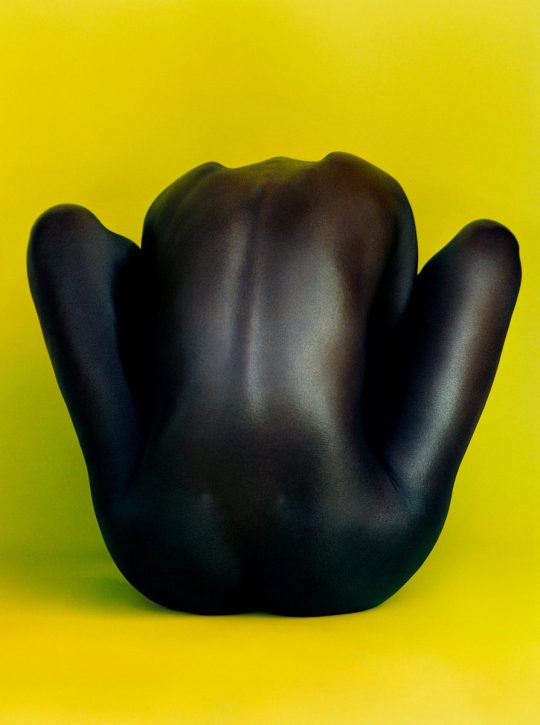
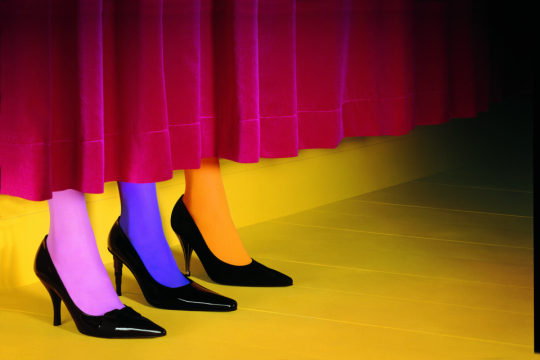


0 notes
Text
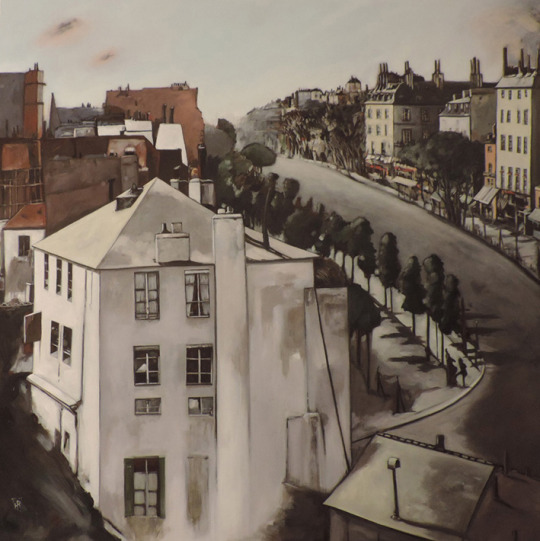
The man from the Boulevard du Temple - Hugues Renck , 2014.
French , b. 1967 -
Oil on canvas , 100 x 100 cm.
96 notes
·
View notes
Text
16 notes
·
View notes
Photo

The First Daguerreotype Photo
In the early 19th century, photography as we know it today did not exist. The process of capturing images was a cumbersome and time-consuming one, requiring extensive knowledge of chemistry and optics. It wasn't until 1839 that the French inventor Louis Daguerre changed the course of history with his revolutionary process, the daguerreotype. The first photograph ever made using this process was known as the "View of the Boulevard du Temple."
Louis Daguerre and the Daguerreotype Process
Louis Daguerre was a French artist and inventor who, together with Joseph Nicéphore Niépce, developed the daguerreotype process. This process involved exposing a silver-coated copper plate to iodine vapor, which created a light-sensitive surface. The plate was then exposed to light in a camera, and the image was developed using mercury vapor. The resulting image was a unique, one-of-a-kind photograph with exceptional detail and sharpness.
The "View of the Boulevard du Temple"
The "View of the Boulevard du Temple" is one of the most famous photographs in history. It was taken by Daguerre in 1838 or 1839, and it depicts a busy street scene in Paris. The image is remarkable for several reasons, not the least of which is that it is the earliest known photograph of a human being.
The Challenges of Capturing the Image
The process of taking the "View of the Boulevard du Temple" was not an easy one. The daguerreotype process was notoriously difficult to work with, and it required a great deal of skill and experience to produce a good image. Daguerre himself struggled with the process for years, and it was not until he teamed up with Niépce that he was able to create a practical photographic process.
The Significance of the Image
The "View of the Boulevard du Temple" is significant for several reasons. First, it is the first known photograph to depict a human being, although the person is likely to have been a street vendor who was standing still long enough to be captured by the long exposure. Second, the image is a striking example of the daguerreotype process, which was the first practical method of photography. Finally, the image is a window into the past, giving us a glimpse of life in Paris in the mid-19th century.
Preservation and Legacy
The original daguerreotype plate used to create the "View of the Boulevard du Temple" is now lost, and only a few copies of the image exist. Nevertheless, the photograph remains an important part of photographic history, and it continues to inspire and influence photographers today. The daguerreotype process may have been superseded by newer, more efficient methods of photography, but its legacy lives on in the form of this iconic image.
Conclusion
The "View of the Boulevard du Temple" is a remarkable photograph that captures a moment in time in the early history of photography. It represents the culmination of years of experimentation and hard work by Louis Daguerre and Joseph Nicéphore Niépce, and it is a testament to the enduring power of the daguerreotype process. Today, the photograph serves as a reminder of the incredible advances that have been made in the field of photography, and it stands as a testament to the creativity and ingenuity of the human spirit.
Source: The Daguerreotype Camera: A Revolution in Photography
#daguerreotype#daguerreotype camera#daguerreotype photo#photography history#camera history#boulevard du temple#louis daguerre#joseph nicephore niepce#19th century photography#photography legacy#photograph history
10 notes
·
View notes
Text
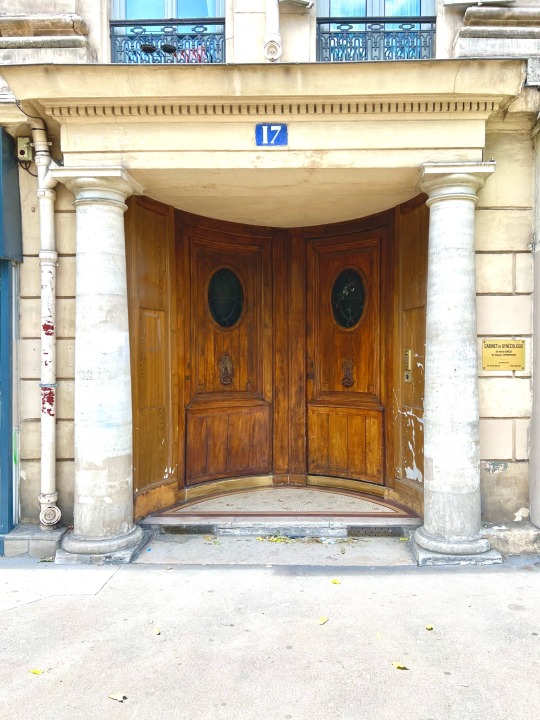
Sur le boulevard du Temple,
Étrange entrée.
Les portes forment une abside,
Un chœur, un tabernacle.
Une niche où s’abriter,
En attendant, un jour de pluie,
Que l’amant descende ouvrir.
Un refuge à mendigots,
Pour souffler quelques instants,
Entre deux passages de condés.
3 notes
·
View notes
Text
Discours de politique générale de M. Barnier : flot d’eau tiède
Michel Barnier s'est montré évasif sur la proportionnelle....
Temps de lecture = 5 minutes Et antirépublicain, car il ignore ce droit de l’homme de 1789, la souveraineté de la nation : il ne veut pas rendre leur pouvoir aux Français. Par Henri Temple Nous avons besoin de VOUS pour poursuivre notre combat face à la dictature de la pensée unique.Cliquer ICI pour nous soutenir ⬆︎⬆︎⬆︎⬆︎⬆︎⬆︎⬆︎ [POINT DE VUE] Discours de politique générale de M. Barnier :…
#boulevard voltaire#discours de politique générale#flot d&039;eau tiède#Henri Temple#Macron#Michel Barnier#Observatoire du MENSONGE#politique
0 notes
Text
Armand, Haussmann, and Paris:
The thing about Paris that's not really discussed in the VC books themselves is the Haussmann project.
In 1853 Napoleon III commissioned Haussman to completely renovate Paris. The plan was to tear down all of the old structures and rebuild the city; reorganizing the streets and reshaping them to accommodate more green spaces, and replacing smaller buildings with taller apartment blocks in more uniform style.
The Paris Armand knew when he arrived as the coven master and which he came to know as the theater leader would have looked something like this:
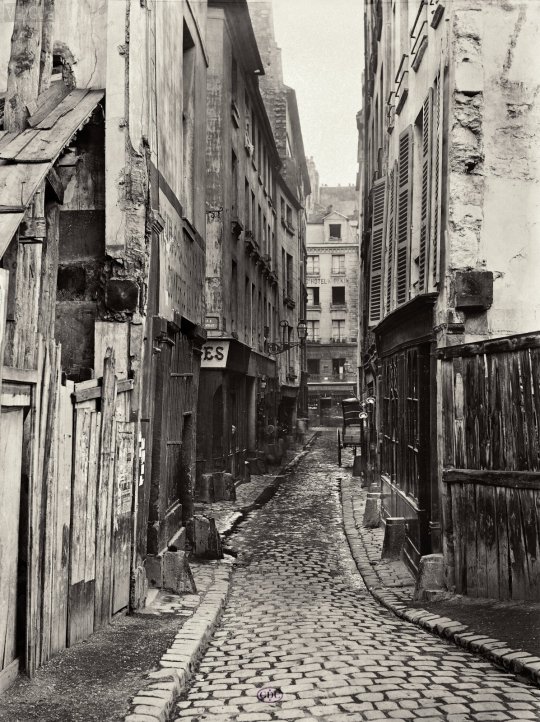


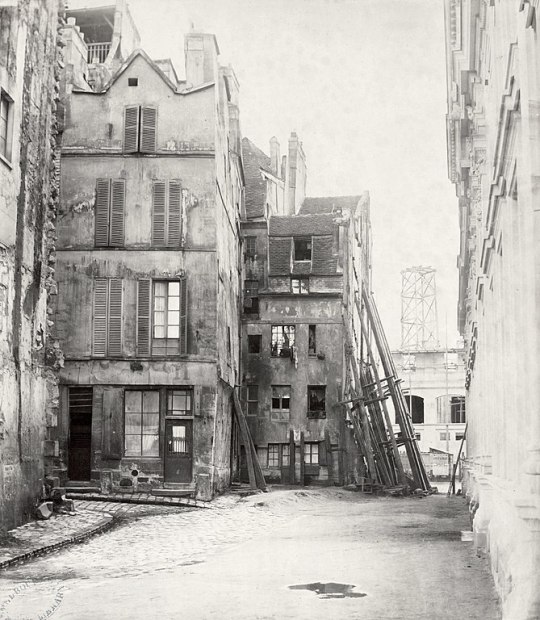
Dark, winding streets leading off wide boulevards and short, leaning buildings.
The Haussman project would see all of these places systematically torn down, occupants removed to other areas of the city while new buildings were put in their place. In some areas workers were destroying and rebuilding things 24 hours a day.
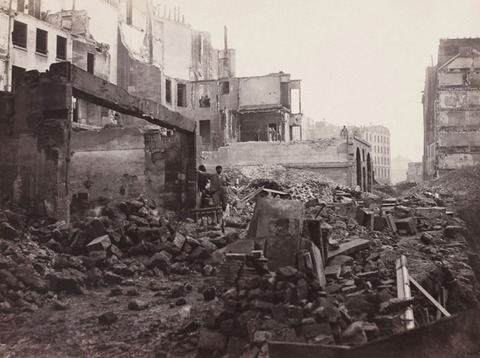
At this time Armand would have been living at the theater on the boulevard du Temple, Paris's street of theaters:

This dagguerotype shows the boulevard in 1838. This painting, in 1862, looks much the same:
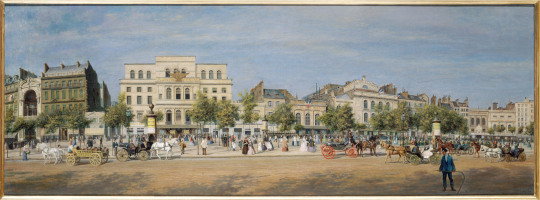
But by 1863 all but one theater on the street had been destroyed, and that was only because that theater was on the opposite side of the street shown in the painting. How and why it wasn't pulled down, I don't know- no information on it seems to exist, just like no explanation for the very small handful of other old structures that were left untouched.
That theater, the Théâtre Déjazet, still exists today. But it was established in 1770 by Comte de Artois, so while it could have been Anne's inspiration for Armand's theater it's not the 'rickety wooden rat trap' that seats 300 that Lestat describes in TVL.
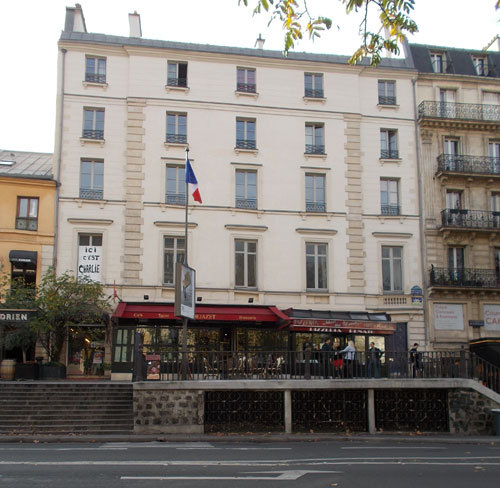
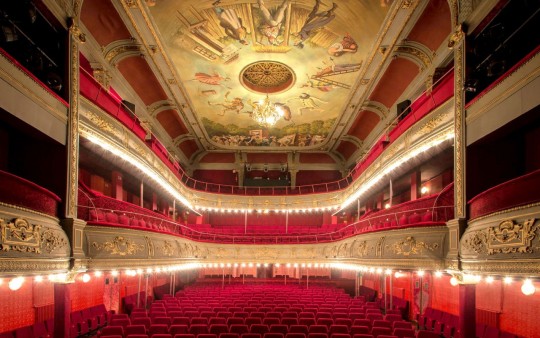
Anyways, knowing all of this, I think it makes even more sense why Armand so quickly grabbed onto Louis and was ready to run away with him at any cost.
Armand, who'd been kidnapped from the monks, who'd had his palazzo torn out from under him, who'd established something of an existence under Les Innocents and was then ripped out of that world when the cemetery was destroyed. Who was watching the city he'd finally come to know get systematically torn apart. Everything that was familiar to him was being taken again.
So why not let Louis burn the theater? He arrived in Paris in 1870, just as Haussman was dismissed. But the work of destroying and rebuilding Paris was set to carry on. Chances were the Theatre de Vampires would be next, and if that were the case there's no way the crypts beneath the place would remain safe and undiscovered.
And if he'd stayed where would they go during the renovation? What would they do? What would the point be in continuing trying to run a coven he was bored of and a life he didn't care for in a new location?
Armand was going to have to begin again somewhere- better that be with Louis, out in the world, than roaming a now unfamiliar Paris. And even though he didn't burn the theater himself, allowing/instigating Louis to do it still gave him more control than letting a stranger come in at some unpredictable moment to demolish things all over again.
(And what of Lestat, what does he feel about these changes? He never could have shown Louis the Paris he knew and loved, which existed when Louis was still mortal- that Paris was largely gone)
Chances were Anne might not have known most of this at the time she wrote interview or even TVL. But I think it still makes a lot of sense and brings up a point about Armand and immortality that I don't see brought up much- that not only do vampires lose every mortal they've ever known, but with time they also see the destruction of every place they've ever known or loved.

(ps: I'm not an expert on this topic or anything, so if anyone does know why some buildings were unchanged or has any interesting historical info to add by all means please, reblog and add it on!)
#paris was amazing#but man standing outside boullion and seeing the last theater on the street#made it really hit hard that nothing stays#and those things that do stay aren't at all the same#and knowing now that paris was transformed in just a couple decades#and the paris louis was so amazed by had so little ties left#to the paris that would have existed when he was a boy#it's a lot!!!!!#vc meta#armand#louis de pointe du lac
94 notes
·
View notes
Text

boulevard du temple, paris
76 notes
·
View notes
Text
What if Louis/Armand in AMC IWTV is meant to be torture... for Lestat?
Basically... what if the whole relationship between Louis and Armand, going back to when Armand first encountered him, is a deliberate "fuck you" to Lestat by Armand, and that is his chief motive for having the relationship at all? For keeping Louis in a gilded prison, for making Louis his love at all, for allowing the interview, and for little things like telling Lestat that Louis was injured, but not telling him where or how to help or passing on the "I love you" to Louis, and perhaps effectively keeping Louis away from Lestat ever since in a game of keep-away, as the most effective way to torture Lestat that Armand has in his possession.
I want to preface this theory by saying it's probably a bridge too far. That's a lot of premeditated malice to ascribe to Armand. I do think there was and is love there between Armand and Louis as seen in the show.
But at the same time... this might surprise some show watchers, but book Armand is an ancient creature of malice who uses his boyish looks to appear soft and gentle when he is anything but. He's over 500 years old and he spent 200 of those years running the Paris Children of Darkness, a Satanic organization that gave his life meaning and purpose during those years.
And even with show Armand, we've seen him capable of playing the long game, pretending to be someone else in Season 1 as he played Fake Rashid, with motives for doing so that are still inscrutable.
We've already seen as of ep 2.6 that Lestat broke up Armand's Paris Coven, the Children of Darkness. But I want to get into why Armand might have been lying about how he was fine with it, that he saw it coming for years, that Lestat was just the instrument of his own desire to move on from that squalid situation.
What if he wasn't fine with it? What if he still isn't fine with it? What if the long game, ever since, is to take everything away from Lestat that Armand can get his hands on, including Claudia, but especially Louis?
Well, to give my evidence for this I'll have to delve into the books a bit, so proceed at your own risk for spoilers.
Here's an excerpt from The Vampire Lestat, with Armand speaking to Lestat after the events in Paris, when he forced Lestat to testify in the trial against Louis and Claudia, because it was always Armand's plan to put Claudia on trial so he could get rid of her and have Louis for himself. For Louis to be buried alive in punishment so that Armand could save him and they could depart together:
"[Armand] leaned forward, and his face transformed itself as it had done years and years ago, as if his rage were melting it from within.
“You, who destroyed all of us, you who took everything. Whatever made you think that I would help you!” He came closer, the face all but collapsed upon itself. “You who put us on the lurid posters in the boulevard du Temple, you who made us the subject of cheap stories and drawing room talk!” ...
...“We had our Eden under that ancient cemetery,” he hissed. “We had our faith and our purpose. And it was you who drove us out of it with a flaming sword. What do we have now! Answer me! Nothing but the love of each other and what can that mean to creatures like us!”"
Armand plays the long game. Armand is a creature of spite and malice, at least through Lestat's eyes in his own autobiography.
Armand was not fine with the Paris Coven being dispelled. He was not fine with Lestat's generosity or the new purpose given to him by Lestat by establishing the Theatre des Vampires. He loathed it.
And after this above exchange with Lestat, Armand picked up Lestat and flew him up high above Paris and dropped him. Armand did that to Lestat in the books, it wasn't Lestat to Louis (though that could simply be a change for the show, or perhaps even reinvented as a deliberate act of revenge on Louis' behalf for what Lestat did to him, and not some sort of mind alteration by Armand but... we'll see.)
It would be a hell of a twist to end the season on. Arguably, a twist akin to the reveal of Rashid-is-actually-Armand at the end of the first season. That this has all, all of it, since the 1940s been one long revenge play against Lestat.
Again, I think it's probably a bridge too far, too cartoonishly evil, but...man, there is that but lingering in my mind. Because this is the sort of thing Armand would do. He's done it before in the books with the trial of Louis and Claudia being one elaborate pantomime to punish Lestat and Claudia and get Louis to himself.
And it's been bothering me ever since the reveal at the end of S1 that we're in an AU where Louis/Armand stayed together instead of breaking up right after Paris like they did in the book. And if I was writing this canon divergence AU, it would be a hell of a thing to make the pivot point be, "No, Louis and Armand didn't break up because Armand wouldn't let Louis go because all of this has been one long elaborate fuck you to Lestat for destroying the Children of Darkness and robbing Armand of the purpose he'd had in life for over 200 years." 70 years of revenge by comparison? That's nothing.
#iwtv#iwtv spoilers#iwtv meta#vampire chronicles#loumand#not exactly pro or anti loumand just speculating that there's more to it#the vampires are not nice people#and Armand is really REALLY not a nice person
78 notes
·
View notes
Text

The Canal Saint-Martin is a 4.6 km long canal in Paris, connecting the Canal de l'Ourcq to the river Seine. Nearly half its length, between the Rue du Faubourg du Temple and the Place de la Bastille, was covered in the mid-19th century to create wide boulevards and public spaces on the surface. Wikipedia
111 notes
·
View notes
Text
Thought of the day: Armand has spent more time in France than Lestat by several orders of magnitude. Lestat is born and raised there, but leaves when he’s around 20. While he does come back, as evidenced in moments like the trial, he spends a long time away. Meanwhile Armand was the leader of the Parisian coven for like�� 250-300 years, and then the Theatre for another 150. Armand’s spent most of his life in Paris.
I just feel like the amount of time he’s spent there is something I never properly considered, especially when compared to the Frenchman.
How does he feel about watching the city itself changing around him? About the fact that Les Innocents no longer exists? French was fourth and poorest of his languages once, I’m sure it isn’t anymore (speaking of, French, Italian, anyone want to weigh in on what languages three and four are?)
When does the Theatre become an institution on the Boulevard du Temple? Does it as the neighbourhood changes in its entirety? Are there old bones of his former coven members preserved in the Louvre alongside the paintings with him in them?
Is there relief or grief when Les Innocents is destroyed? How about when the theatre goes up in flames? Does he read the news articles talking about its destruction?
Like we all know there’s Venice shaped traumas and rose tinted lenses some days, but tell me more about Armand in Paris. Can he really live somewhere for the 4/5th of his life give it take and then walk away with barely a backward glance.
If he ever returns, what is that like for him?
#iwtv armand#amc iwtv#amc interview with the vampire#interview with the vampire#lestat de lioncourt#Armand#france#paris france#theatre des vampires#children of darkness#children of Satan
48 notes
·
View notes
Text
I reread the end of TVL last night and pulled out some of Lestat’s account of the trial for anyone who hasn’t read the book. I tried to keep out any direct spoilers but obviously we don’t know how the show will adapt this part. Anyway I thought it was worth a refresh on what Lestat says happens leading up to the trial and the aftermath of it. This is kind of a long post but it’s interesting even if you don’t plan on reading TVL. Under the cut for length/spoilers-
Here he describes the period of time after his ‘death’. He needs blood from a strong vampire to recover but is alone now:
But without more of that healing blood, without a fresh infusion, I was left at the mercy of time to heal my wounds.
And what Louis could not describe in his story is what happened to me after, how for years I hunted on the edge of the human herd, a hideous and crippled monster, who could strike down only the very young or infirm. In constant danger from my victims…
The wounds I'd suffered affected my very spirit, my capacity to reason.
With no one else to turn to, he eventually goes to Armand for help. I’m curious about this in the show because the coven tries to contact him via his bank dude but it could be that Lestat is actually already nearby/came to Paris on his own. He may even be trying to find Louis and Claudia before the coven does.
When I had recovered sufficiently to make the long voyage to Europe, I turned to the only one that I could turn to: Armand. Armand who lived still on the land I'd given him, in the very tower where I'd been made by Magnus, Armand who still commanded the thriving coven of the Theater of the Vampires in the boulevard du Temple, which still belonged to me.
Armand plays innocent and gets Lestat to tell him what happened to him:
Once again his eyes moved over me caressingly.
And there was thinly veiled excitement in him, a fever that I could feel like the warmth of the nearby fire. I knew he was trying to read my thoughts.
"What's happened to you?" he asked.
My scars were puzzling him. They were too numerous, too intricate, scars of an attack that should have meant death.
Armand had told Lestat earlier in the book that his fledglings would always hate/resent him, echoed in that bit in the show where Louis is talking about turning Madeline.
But it was the story of Louis and Claudia that came rushing out, in stammering and half truths, sans one salient fact: that Claudia had been only... a child.
I told briefly of the years in Louisiana, of how they had finally risen against me just as he had predicted my children might. I conceded everything to him, without guile or pride, explaining that it was his blood I needed now. Pain and pain and pain, to lay it out for him, to feel him considering it. To say, yes, you were right. It isn't the whole story. But in the main, you were right.
This could be where Armand gets such a detailed account of their lives for the play. Between Lestat’s account, Armand maybe reading his and Louis’ mind and Claudia’s diaries, they have a pretty complete if biased picture to work off.
Was it sadness I saw in his face then? Surely it wasn't triumph. Unobtrusively, he watched my trembling hands as I gestured. He waited patiently when I faltered, couldn't find the right words.
A small infusion of his blood would hasten my healing, I whispered. A small infusion would clear my mind. I tried not to be lofty or righteous when I reminded him that I had given him this tower, and the gold he'd used to build his house, that I still owned the Theater of the Vampires, that surely he could do this little thing, this intimate thing, for me now. There was an ugly naiveté to the words I spoke to him, addled as I was, and weak and thirsting and afraid. The blaze of the fire made me anxious. The light on the dark grain of the woodwork of these stuffy rooms made imagined faces appear and disappear.
"I don't want to stay in Paris," I said. "I don't want to trouble you or the coven at the theater. I am asking this small thing. I am asking ..." It seemed my courage and the words had run out.
A long moment passed:
"Tell me again about this Louis," he said. (!!!)
The tears rose to my eyes disgracefully. I repeated some foolish phrases about Louis's indestructible humanity, his understanding of things that other immortals couldn't grasp.
Armand is likely already seeing Louis at this point, keep in mind.
I saw something in him quicken. A faint blush came to his cheeks.
"They have been seen here in Paris," he said softly. "And she is no woman, this creature. She is a vampire child."
I can't remember what followed. Maybe I tried to explain the blunder. Maybe I admitted there was no accounting for what I'd done. Maybe I brought us round again to the purpose of my visit, to what I needed, what I must have. I remember being utterly humiliated as he led me out of the house and into the waiting carriage, as he told me that I must go with him to the Theater of the Vampires.
"You don't understand," I said. "I can't go there. I will not be seen like this by the others. You must stop this carriage. You must do as I ask."
"No, you have it backwards," he said in the tenderest voice.
Armand then traps him under the theater and starves him until he is forced to drink dead blood. I’m imagining this or a similar version of events is going on while Armand is dating Louis and Claudia is an active coven member. Remember Louis asking Armand if all this was happening while they were together in his flat?
I scarcely remember being forced by him out of the carriage and stumbling along the broad pavements as he pushed me towards the theater doors.
…
And finally starvation as I lay on the floor of a brick-lined cell, unable even to shout curses at him-
Sometime in the dark, I discovered a mortal victim there. But the victim was dead. Cold blood, nauseating blood. The worst kind of feeding, lying on that clammy corpse, sucking up what was left.
Armand tells Lestat about this trial when he’s very ill:
And then Armand was there, standing motionless in the shadows, immaculate in his white linen and black wool. He spoke in an undertone about Louis and Claudia, that there would be some kind of trial. Down on his knees he came to sit beside me, forgetting for a moment to be human, the boy gentleman sitting in this filthy damp place. "You will declare it before the others, that she did it," he said.
Armand then gets him all dressed up for the trial so he looks fashionable and not like he’s being tortured-
"Get clothing for him," Armand said. His hand was resting on my shoulder. "He must look presentable, our lost lord," he told them. "That was always his way."
And then Armand makes him testify against Claudia- don’t know how this will work with this being a play that was rehearsed. But I feel it’s likely that Lestat was coerced more than we’ve seen.
—and Armand saying:
"You will say what I have told you to say." It was a mob tribunal of monsters, white-faced demons shouting accusations, Louis pleading desperately, Claudia staring at me mute, and my saying, yes, she was the one who did it, yes, and then cursing Armand as he shoved me back into the shadows, his innocent face radiant as ever.
"But you have done well, Lestat. You have done well."
Armand then brings him to Magnus’ tower:
And then we went up and up through the old tower to the roof.
I had Claudia's bloody yellow dress in my hands. I had seen her in a narrow wet place where she had been burnt by the sun. "Scatter the ashes!" I had said. Yet no one moved to do it. The torn bloody yellow dress lay on the cellar floor. Now I held it in my hands. "They will scatter the ashes, won't they?" I said. (Upsetting :/)
"Didn't you want justice?" Armand asked, his black wool cape close around him in the wind, his face dark with the power of the recent kill. (Lestat in fact, never said he wanted “justice”)
Armand then tries to convince Lestat that Louis is dead. I think they might be shifting this part to Louis’ 1973 suicide attempt.
Armand's eyes were red.
"Louis—where is he?" I asked. "They didn't kill him. I saw him. He went out into the rain ..."
"They have gone after him," he answered. "He is already destroyed."
Liar, with the face of a choirboy.
"Stop them, you have to! If there's still time..."
He shook his head.
"Why can't you stop them? Why did you do it, the trial, all of it, what do you care what they did to me?"
"It's finished."
…
This part here explains that Armand really would side with his coven, but also attempt to keep Louis:
"And you don't mean to help me, do you?" Despair.
He leaned forward, and his face transformed itself as it had done years and years ago, as if his rage were melting it from within.
"You, who destroyed all of us, you who took everything. Whatever made you think that I would help you!" He came closer, the face all but collapsed upon itself. "You who put us on the lurid posters in the boulevard du Temple, you who made us the subject of cheap stories and drawing room talk!"
…
"We had our Eden under that ancient cemetery," he hissed. "We had our faith and our purpose. And it was you who drove us out of it with a flaming sword. What do we have now! Answer me! Nothing but the love of each other and what can that mean to creatures like us!”
Then Armand pushes him out of the tower-
“You don't understand anything. You never did." But he wasn't listening to me. And it didn't matter whether or not he was listening. He was drawing closer, and in a dark flash his hand went out, and my head went back, and I saw the sky and the city of Paris upside down.
I was falling through the air.
And I went down and down past the windows of the tower, until the stone walkway rose up to catch me, and every bone in my body broke within its thin case of preternatural skin.
————————
Now 2x08 showed a very different version of the tower scene- for one, Louis was never supposed to be there- but I am not convinced whatsoever that it’s what actually happened. It feels way too much like an Armand version of events and since this portion is so importantly clarified by Lestat, I don’t think we’ll see what really happened until Lestat tells it. Obviously it will be different and Louis may still be present for it, but im curious to see how this part is handled by season 3. I think there will be some big changes to fit with the show canon, but I also think it’s still going to have elements of Lestat’s version. Especially because when Louis sees Lestat finally in 2022, Lestat is still not mentally recovered from this event after 80+ years.
#iwtv#iwtv spoilers#interview with the vampire#amc interview with the vampire#amc iwtv#the vampire lestat
41 notes
·
View notes
Text
12 notes
·
View notes
Text

LOOKING FOR A JOB THAT WON'T SUCK? JOIN THE FAMILY! - SEND YOUR CV @ THÉÂTRE DES VAMPIRES, BOULEVARD DU TEMPLE, PARIS (FR)
[another version under the cut]

#interview with the vampire#iwtv#theatre des vampires#amc iwtv#amc interview with the vampire#my art#captain's log#they won't give me a stage crew shirt as merch so i made my own..........#my stuff#anyway i had this in the backlog for like a week because its just me playing with pngs like dolls but still
29 notes
·
View notes
Text
Things my special interest makes me immune to: most "eerie" "haunted" "look at this terrifying creepy thing" social media shit that's just like a grainy black and white photo or some 1950s jazz. Recordings of old-timey music isn't going to make me anxious, it's going to make me listen to some nice music that was very popular in a certain decade just like the mid-2000s pop you and I have so much nostalgia about. You try to spook me by showing me the terrifying Boulevard du Temple photograph and I'll laugh in your face because I know the exact process by which the photo was taken and why the clarity was limited by the technology and I also have a trained empathy for humans who lived in times so long ago you think they're practically aliens, and to me the photo looks like a street corner in urban France featuring the first ever photobomber in history, a man getting his shoes polished on a day out. He's probably having a wonderful afternoon, I don't know. "Doesn't it creep you out that everyone in this photograph is dead now?" No. Most people who have ever lived are dead now. One day the person in all my selfies will be "dead now." Come to terms with it now or you'll kill yourself stressing about how to live forever.
Maybe YOU look at a photo of a party from the 1880s and see a sinister supernatural force trying to possess you through the screen. I see a moment in time in which these very real people were existing and having enough fun to want to take a selfie. And how cool that we get to hold onto that for them all these years later.
23 notes
·
View notes
Text

Théâtre de la Gaîté, boulevard du Temple, Paris XIe, 1862.
12 notes
·
View notes